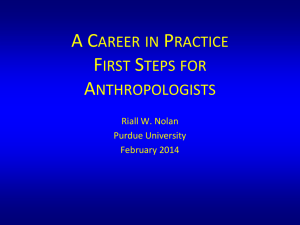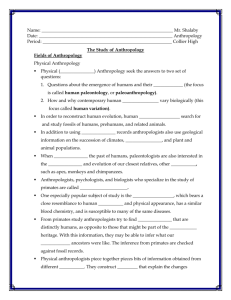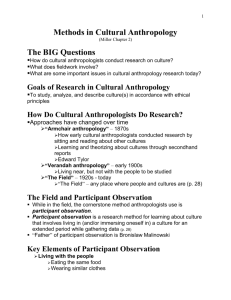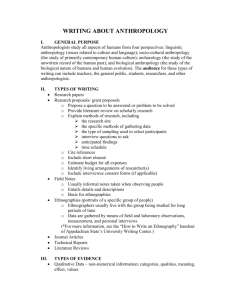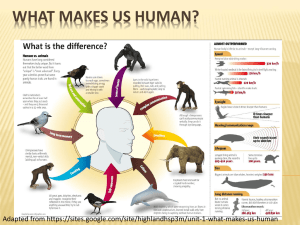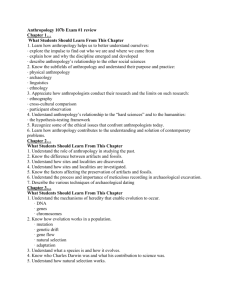Skoggard-Kennedy-final - Human Relations Area Files
advertisement
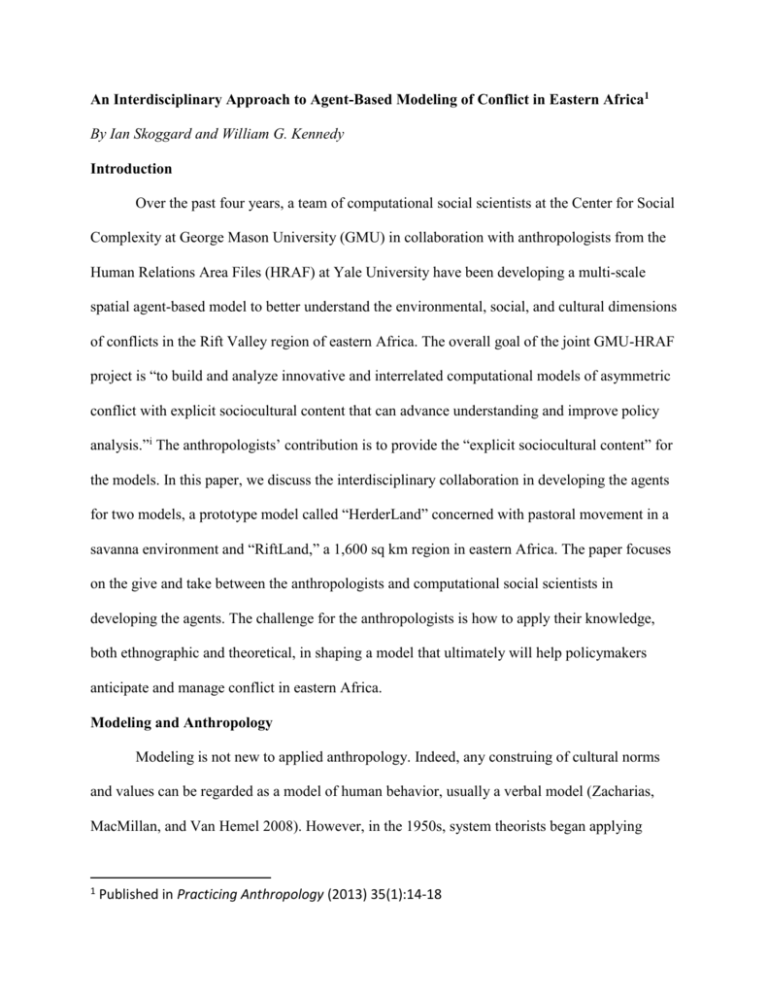
An Interdisciplinary Approach to Agent-Based Modeling of Conflict in Eastern Africa1 By Ian Skoggard and William G. Kennedy Introduction Over the past four years, a team of computational social scientists at the Center for Social Complexity at George Mason University (GMU) in collaboration with anthropologists from the Human Relations Area Files (HRAF) at Yale University have been developing a multi-scale spatial agent-based model to better understand the environmental, social, and cultural dimensions of conflicts in the Rift Valley region of eastern Africa. The overall goal of the joint GMU-HRAF project is “to build and analyze innovative and interrelated computational models of asymmetric conflict with explicit sociocultural content that can advance understanding and improve policy analysis.”i The anthropologists’ contribution is to provide the “explicit sociocultural content” for the models. In this paper, we discuss the interdisciplinary collaboration in developing the agents for two models, a prototype model called “HerderLand” concerned with pastoral movement in a savanna environment and “RiftLand,” a 1,600 sq km region in eastern Africa. The paper focuses on the give and take between the anthropologists and computational social scientists in developing the agents. The challenge for the anthropologists is how to apply their knowledge, both ethnographic and theoretical, in shaping a model that ultimately will help policymakers anticipate and manage conflict in eastern Africa. Modeling and Anthropology Modeling is not new to applied anthropology. Indeed, any construing of cultural norms and values can be regarded as a model of human behavior, usually a verbal model (Zacharias, MacMillan, and Van Hemel 2008). However, in the 1950s, system theorists began applying 1 Published in Practicing Anthropology (2013) 35(1):14-18 mathematics to describe social phenomena (Rodin et al. 1978). More recently, social scientists began using computational methods, primarily simulation, to allow researchers to conduct experiments that cannot be done in the field. One approach called agent-based modeling (ABM) supported modeling of individual people as agents in a system in which they interact with other agents and the environment. With more powerful computers, it is possible to build up a representation of both natural and human-made environments, drop in rule-governed agents, and then observe their behavior over time and space. ABM is able to reveal in a unique way the global patterns that emerge from the interaction of individual agents with each other and the environment (Macy and Willer 2002). The emergent patterns can help to validate theory or replicate observed phenomena, and in an experiment-like situation, variables can be isolated and controlled to verify causal effects or patterns observed in the archaeological, historical, or ethnographic record. At its best, the computer can mimic decision making processes in a way more sophisticated than simple stimulus-response behavior and perfect-knowledge rationality. A model can incorporate limited information, limited cognitive abilities, and limited time to make decisions, thus replicating more truthfully real-life situations and experience (Kennedy and Bassett 2011). Memory and emotions can be included as well (Kennedy and Bassett 2011). The biggest challenge for the computational social scientist is how best to represent people’s cognition and social interactions. This is where the anthropologist’s input has been most helpful. By developing a more culturally attuned model, it is hoped by both teams that the model could have applications in other anthropological type investigations. A few ABM studies have been made in the field of anthropology to date. One agentbased computational model reproduced settlement patterns and population fluctuations of an Anasazi community using data based on the paleoenvironmental record and ethnographic studies of historic Pueblo groups (Axtell et al. 2002). The simulated population growth and settlement patterns followed the actual archaeological record except for the final phase when historically the valley was abandoned, but the model showed a small community lingering on. The authors attributed the difference to social and cultural dynamics not accounted for in the model. In cultural anthropology, a few researchers have modeled pastoral groups by combining ecosystem and household simulation models. One study using the integrated model examined the effect of cultivation on wildlife, livestock, and pastoralists in a conservation area in Tanzania (Boone et al. 2006). Another study examined the effects of land fragmentation and ranching on pastoral communities in Kenya (Thornton et al. 2006). Using another ABM model, researchers examined the effect of drought on trading and raiding behavior between pastoral and farming households in Darfur, Sudan (Kuznar and Sedlmeyer 2005). Another study examined the degree to which mutual trust between herders and farmers affected access to grazing land and reproductive success of the herd (Rouchier et al. 2001). These studies have helped to develop models for applied anthropology and contributed to land management and conservation policy decision making. However, these and other models are still in a rudimentary stage of development, beginning at the beginning, as with the HerderLand model described below. Think of Steve Jobs in his parents’ garage in the late 1970s. HerderLand Prior to their collaboration with HRAF, the modelers at George Mason developed a model called HerderLand simulating day-to-day grazing and seasonal migrations of herds in a savanna environment. HerderLand has a uniform area approximately 150 X 150 km. sq. with little varied geographic or meteorological data. The model uses a multiagent simulation environment and visualization library (MASON) written in the Java programming language (Luke et al. 2005). When herding, the herders decide daily where to move the herd based on four factors. These factors represent the herd’s level of hunger, level of thirst, whether there is conflict in the area, and how far away the herd may have to move. The rules are implemented as a hierarchy of ifthen questions based on the importance of the factors modeled. The decision tree is shown in Figure 1.[Insert Skoggard Fig. 1 about here. Caption: Herding Decision Making Tree] The model did produce migratory movements in space and time as agents sought greener parcels and those with watering holes (see Figure 2). [Insert Skoggard Fig. 2 about here. Caption: Migrations of Herds (Circle) From One Watering Hole (Square) to Another (Off Screen)]The next model introduced two types of agents, herders and farmers, to examine pastoralist and agriculturalist interaction. When the anthropologists were consulted, they suggested a variation on the simple fight or flight response of the agents in the earlier model by introducing the concept of ethnicity in which not everyone is regarded as a potential enemy. Members of the same ethnic group would choose to share resources rather than fight over them. Modelers then assigned agents one of two group identities. Running this scenario produced an interesting result in which after a period of time the farmers became a buffer between two hostile groups of herders (Kennedy et al. 2010). Based on their knowledge of ethnographic data of the region, the anthropologists then critiqued the strict division between herders and farmers and suggested an agropastoralist agent who would combine both subsistence practices. This suggestion proved a challenge to the programmers who could assign only one of the two subsistence activities to an agent. One possible solution considered was to have the agent switch between subsistence activities for different units of time: a farmer today and a herder tomorrow. However, a more realistic solution to the problem was to introduce the idea of households made up of multiple individuals who could carry out different subsistence and economic activities. The agropastoralist household unit became the agent for the next stage of modeling. The development of a household agent would be better suited to the household/community focus of applied anthropology. RiftLand Based on HerderLand, a larger more ambitious model was built called RiftLand, which covers a 1,600 X 1600 km. sq region of the Rift Valley in eastern Africa, including all or part of nine countries, approximately 135 ethnic groups, and 120 million people. The purpose of this model is to study conflict, natural disasters, and humanitarian relief needs in a region with a wide variety of natural and human-made environmental factors. The RiftLand model is still in the development stage, gradually incorporating additional layers, greater scale, more diverse behaviors, and a more varied environment. The challenge to programmers and anthropologists was to simplify the ethnographic information to make the modeling more manageable and to avoid overloading the computer itself. The tension between needs for simplicity required by the programming language and the complexity of the ethnographic record would define the interaction between the two teams throughout the collaboration, sometimes with comical results. The anthropologists are always coming up with the exception to the rules that the programmers had worked hard to deduce from the ethnology. In one lighter moment after running a scenario in which the programmers found that none of the farmers died, the anthropologist suggested programming in Original Sin. How then to simplify the ethnographic data to make it more amenable to programmers? Cross-cultural researchers recognize that each culture is unique, but cultures are comparable on dimensions of variation and can be coded on those dimensions (Ember and Ember 2009). In other words, patterns can be identified across cultures and generalizations made, and these generalizations used to type cultures. For example, food procurement for any one culture may be unique with respect to the specific food items obtained, when and how they are obtained, and the proportion that those items contribute to the overall diet. However, there are basic types of foodgetting regimes that allow us to talk in more general terms about hunter-gatherers, pastoralists, and swidden cultivators. The anthropologist George Peter Murdock (1967) published the Ethnographic Atlas, which coded 100 cultural variables across 1,200 cultures worldwide. Although each culture was coded for a specific time and place focus, we decided to use the Atlas’ 5-digit code to estimate the relative dependence on five major subsistence activities. The first digit of the code estimates the dependence of a society on gathering flora and small fauna. A small number such as 1 means only a 6 to 15 percent dependence, whereas a larger number such as 8 means 76 to 85 percent dependence. The second digit refers to hunting, including trapping and fowling; the third to fishing, including shellfish and marine animals; the forth to animal husbandry, which includes pastoralism; and the fifth to agriculture. The individual digits added up together should add up to 10, or 100 percent. The programmers were able to incorporate the code directly into their model. However, not all the RiftLand cultures were coded in the Atlas, and the HRAF anthropologists had to code the remaining cultures. Household Rules The next challenge for the group was developing the decision making rules for the agropastoralist household agent. The development of this new agent required more sophisticated rules regarding how to allocate household labor to different subsistence activities as well as wage labor, which was an option in the larger and more diverse regional economy with its commodity and labor markets. Furthermore, the issue of internally displaced peoples (IDP) and refugees – a reality on the ground – had to be addressed. While the rules for pastoralism were adopted from the HerderLand model, new rules for farming had to be developed, including when to plant, when to harvest, and how much area to plant. These decisions would be informed by the environment, weather, past history of the weather, and availability of labor. Average household size had to be determined and different economic activities prioritized. Rules for how labor was allocated and resources shared between household members had to be developed. If herding and farming activities could not provide for all members of the household, then stored reserves were uncapped and distributed. If reserves were low or non-existent, then a member of the family was sent to work in the closest town. Limits were placed on how much labor a town labor market could absorb. When that limit was reached, wage laborers became displaced persons, and households no longer had to feed them (see Figure 3). [Insert Skoggard Fig. 3 about here. Caption: Decision Making Rules for Agropastoral Household Agent] An initial running of the new model showed a slow trickle of displaced persons, which did not fit the actual reports of IDPs in the literature. The anthropologists assured the modelers that it is not uncommon for poorer households to send individual members to closely related richer households, either on a short- or long-term basis, the latter being some form of adoption. It would then be only under extreme conditions when even wealthier households are hard pressed that a massive displacement of people would occur as reported in the literature. This knowledge opens up the next step for modelers to set rules for relationships and exchanges between households at a community level, adding yet another layer of social and cultural complexity to the model, bringing the model closer to the realm in which applied anthropologists conduct their research. Lesson Learned Although the RiftLand model is far from complete, some lessons have been learned to date for both the anthropologists and computational social scientists working on the project. The first and most obvious lesson was that the two disciplines could communicate, albeit at times it was an exacting and painful process as respective disciplinary certitudes about behavior had to be let go of for the sake of the model and formulation of agent-governing rules. The computational social scientists appreciated the anthropologists’ encyclopedic knowledge about social interactions on many levels, which provided useful data and guidance for social simulation. However, they questioned the significance of some of the data and took the initiative to identify what they felt were the major factors essential to programming the agents. All in all, a level of trust was attained, which obviated the need and no doubt near impossible challenge for anthropologists to think like computational social scientists and vice versa. One lesson for the anthropologists has been how ethnology can be used to help shape the sociocultural landscape of the model. The modelers were able to take the coded data from the Ethnographic Atlas to help create a cultural profile for agents in the different ethnic regions in the model. Indeed, the Atlas may prove to be an invaluable resource and tool in this regard, giving it a new application in the world of computer simulation. The anthropologists also learned how to transpose cultural concepts into daily rule-governed behavior. For example, how does kinship, or ethnic affiliation, shape day-to-day interactions and decision making? The conventional anthropological practice is to tease out of the observed patterns of cultural behavior the rules, norms, and values that structure them. In modeling, anthropologists do the reverse by setting rules that they hope will produce the patterns they associate with observed cultural behavior. For example, with the suggestion to the programmers that they assign different ethnicities to herding agents and then have agents with the same ethnicity share rather than fight for pasturage or water, the anthropologists crossed their fingers for interesting results. The formation of ethnic enclaves in the model, which reflects real-life observations, can be regarded as a validation of sharing as a key component of ethnic cultural behavior and confirm for the practicing anthropologist that the model is working on a basic level. Another insight the anthropologists garnered from their collaboration with computational social scientists in developing an agent-based computer model has been a deeper appreciation of the multi-layered scalar relationships between culture, agency, and the environment. While cultural practices have their own internal logic, it is not a logic entirely divorced from the environment and larger systems in which a community is embedded. A new synthetic ecological anthropology recognizes that communities are embedded in multiple systems of different scale, including local, regional, national, and global (Kottak 1999); and that political, historical, and symbolic dimensions mediate the human-nature relationship (Biersack 1999). This basic insight to the integral relationship between symbolic behavior, social relationships, and the environment remains relevant (Moran 2006). We need only look at the crisis we face today of climate change and the societal failure to recognize and respond to the larger ecological cycles in which our society is embedded. Our present-day climatic crisis is a hard reminder that culture and the environment are more closely linked than we dare imagine. Global warming and its fallout could well be a case of environmental determinism in the last instance! We would argue that symbolic behavior is related to large-scale, long-term ecological cycles, which ultimately have a significance for group survival. Conclusion Computer modeling is making its way into anthropology and, as evident in the other papers in this issue, is being readily accepted by practicing anthropologists. While some anthropologists accept computer modeling as a powerful new tool for research, others may have reservations about how it might undermine disciplinary ideals of cultural relativism, complexity and holism, and above all the validity and richness of the ethnographic encounter. The abstraction that modeling requires may seem to be a form of reductionism and therefore a step backward in a discipline that has attained a more nuanced understanding of human behavior and more sophisticated social theories. Perhaps there is also the fear of loss of control of the methodological process. Adopting Marx’s dictum about history, practicing anthropologists often find themselves practicing their craft under circumstances they have not themselves chosen. Nevertheless, their work often takes them in interesting directions with interesting results. Such has been the case in this interdisciplinary collaboration between anthropologists and computational social scientists in developing an agent-based model of conflict in East Africa. Models have a potential to reveal the complex pattern of relationships between agency, culture, and environment. Indeed, models might be the tool of choice in exploring this most complex cultural ecology of human-planet exchange. Acknowledgments This work was supported by the Center for Social Complexity at George Mason University and by the Office of Naval Research (ONR) under a Multidisciplinary University Research Initiative (MURI) grant no. N00014-08-1-0921. The authors would like to acknowledge input from the Mason-HRAF Joint Project on Eastern Africa (MURI Team), particularly Tim Gulden for his original concept and implementation of the formula-based approach to agent decision making and Jeff Bassett for implementation of the “fast and frugal” approach in the HerderLand and RiftLand models. We also thank Carol R. Ember and Teferi Abate Adem for their comments and suggestions. The opinions, findings, and conclusions or recommendations expressed in this work are those of the authors and do not necessarily reflect the views of the sponsors. References Cited Axtell, Robert , Joshua Epstein, Jeffrey Dean, George Gumerman, Alan Swedlund, Jason Harburger, Shubha Chakravarty, Ross Hammond, Jon Parker, and Miles Parker 2002 Population Growth and Collapse in a Multiagent Model of the Kayenta Anasazi in Long House Valley. Proceedings of the National Academy of Sciences 99(90003):72757279. Biersack, Aletta 1999 Introduction: From the “New Ecology” to the New Ecologies. American Anthropologist 101(1):5-18. Boone, Randall , Kathleen Galvin, Philip Thornton, David Swift, and Michael BCoughenour 2006 Cultivation and Conservation in Ngorongoro Conservation Area, Tanzania. Human Ecology 34(6):809-828. Ember, Melvin, and Carol Ember 2009 Cross-Cultural Research Methods. Lanham, Md.: Altamira Press. Kennedy, William , and Jeffrey Bassett 2011 Implementing a “Fast and Frugal” Cognitive Model Within a Computational Social Simulation. Proceedings of the Second Annual Conference of the Computational Social Science Society of America, Santa Fe, N.Mex., October 9-12. Kennedy, William ., Atesmachew Hailegiorgis, Mark Rouleau, Jeffrey Basset, Mark Coletti, Gabriel. Balan, and Tim Gulden 2010 An Agent-Based Model of Conflict in East Africa and the Effect of Watering Holes. Behavior Representation in Modeling and Simulation Conference, Charleston, S.C., March 22-26. Kottak, Conrad P. 1999 The New Ecological Anthropology. American Anthropologist 101(1):23-35. Kuznar, Lawrence., and Robert Sedlmeyer 2005 Collective Violence in Darfur: An Agent-Based Model of Pastoral Nomad/Sedentary Peasant Interaction. Mathematical Anthropology and Cultural Theory: An International Journal 1(4):1-22. Luke, Sean, Claudio Cioffi-Revilla, Liviu Panait, Keith Sullivan, and Gabriel Balan 2005 MASON: A Multiagent Simulation Environment. Simulation 81(7):517-527. Macy, Michael, and Robert Willer 2002 From Factors to Actors: Computational Sociology and Agent-Based Modeling. Annual Review of Sociology 28:143-166. Moran, Emilio 2006 People and Nature: An Introduction to Human Ecological Relations. Malden, Mass.: Blackwell Publishing. Murdock, George Peter 1967 Ethnographic Atlas. Pittsburgh, Pa.: University of Pittsburgh Press. Rodin, Miriam, Karen Michaelson, and Gerald M. Britan 1978 Systems Theory in Anthropology. Current Anthropology 19(4):747-753 Rouchier, Juliette, François Bousquet, Mélanie Requier-Desjardins, and Martine Antona 2001 A Multi-Agent Model for Describing Transhumance in North Cameroon: Comparison of the Different Rationality to Develop a Routine. Journal of Economic Dynamics and Control 25(3-4):527-559. Thornton, Philip , Shauna BurnSilver, Randall Boone, and Kathleen Galvin 2006 Modelling the Impacts of Group Ranch Subdivision on Agro-Pastoral Households in Kajiado, Kenya. Agricultural Systems 87(3):331-356. Zacharias, Greg , Jean MacMillan, and Susan Van Hemel, eds. 2008 Behavioral Modeling and Simulation: From Individuals to Societies. Committee on Organizational Modeling: From Individuals to Societies. Washington, D.C.: The National Academies Press. Ian Skoggard (ian.skoggard@yale.edu) did his original fieldwork studying the shoe industry of Taiwan on which he has published various articles, chapters, and a book. Presently, he works as an indexer, editor, and researcher at the Human Relations Area Files. Besides computer modeling, he has an additional interest in affect. WilliamKennedy, Ph.D., CAPTAIN, USN (Ret.) (wkennedy@gmu.edu)[Insert Skoggard Fig.4.tiff about here. Caption: William Kennedy] is a Research Assistant Professor with the Krasnow Institute for Advanced Study at George Mason University. His research focuses on advancing computational modeling of the human mind and integrating cognitive science and cognitive modeling into computational social science. i From the Yearly Report for ONR/MURI:MASON-HRAF Joint Project on Eastern Africa, 2011 Reporting Period of 1 June 2010 through 31 May 2011.

